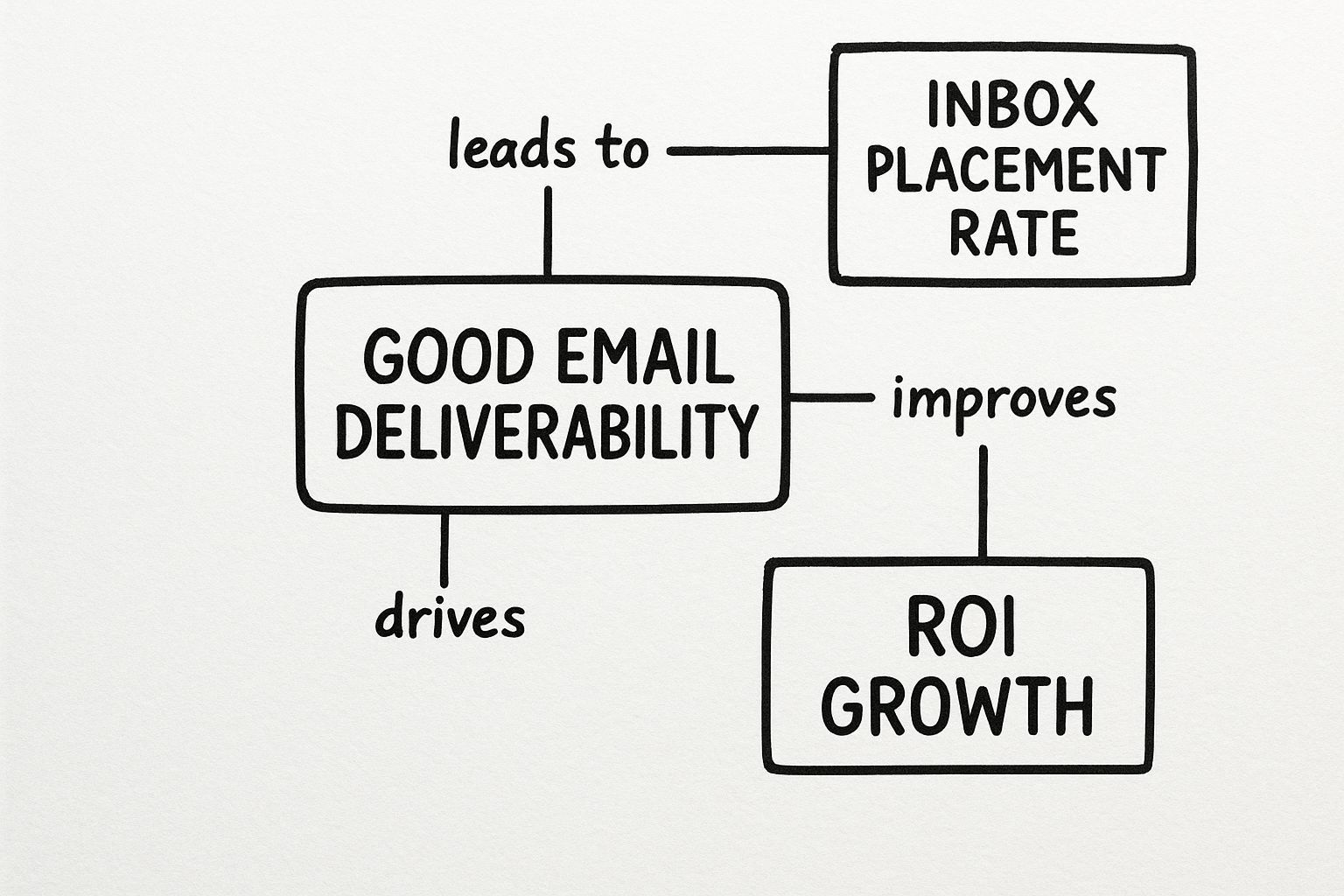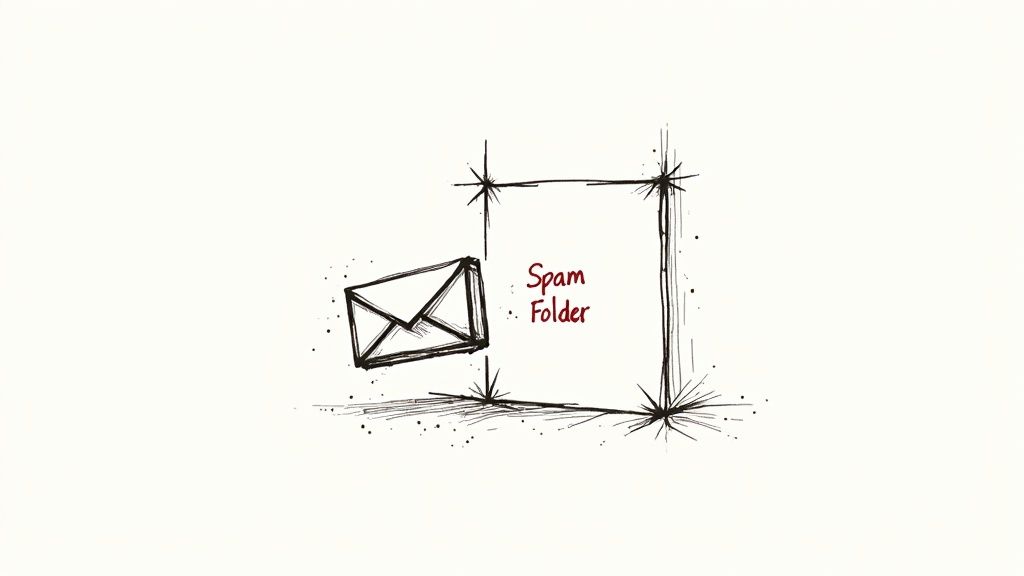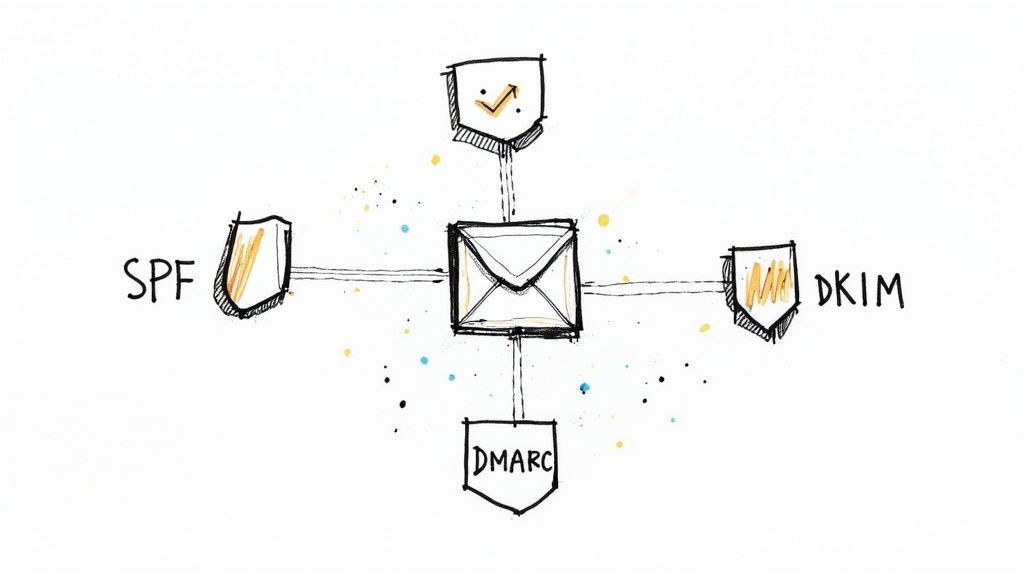Think about the last time you sent a really important email. I mean a really important one—the kind of cold email that could land a huge client or open a massive door for your business. You agonized over the subject line, polished every sentence, and finally, with a deep breath, you hit "send."
But then what?
Does it land in their inbox? Or does it vanish into the digital abyss, get flagged as spam, or just get silently blocked by their server? This uncertainty is the single biggest challenge in cold outreach.
Hitting "send" is just the first step. It doesn't guarantee your message will ever be seen.
What Are Email Deliverability Services?
This is where we need to talk about the critical difference between delivery and deliverability. They sound similar, but in the world of email, they're miles apart.
Delivery vs. Deliverability: The Core Difference
Email delivery is the easy part. It's the technical handshake confirming your email server successfully sent the message and the recipient's server accepted it. It's like getting a "delivered" receipt from the post office. Your package is in their system, but that's it. It doesn't mean it's on the recipient's desk.
Email deliverability, on the other hand, is the real prize. It's the measure of whether your email actually landed in the primary inbox where it has a chance to be read. This is your package being hand-delivered directly to the person it was meant for.
Poor deliverability means your messages are getting buried in spam folders, filtered into less-important tabs, or even deleted before they ever arrive. It makes all your hard work on copy and personalization completely invisible.
To clear this up, here’s a quick breakdown:
Delivery vs. Deliverability At a Glance
For any serious outreach campaign, solving for deliverability isn't just a good idea—it's everything.
The Role of Email Deliverability Services
This is exactly why email deliverability services exist. They aren't just another tool for blasting out emails. Think of them as your strategic partner, dedicated to managing the dozens of complex signals that determine whether you're seen as a legitimate sender or a spammer.
These services proactively build and fiercely protect your sender reputation—the score that providers like Google and Microsoft assign to your sending domain. A great reputation tells them you’re a trusted source. A bad one gets you sent straight to the junk pile.
You can dive deeper into this with our guide on how to check your email sender reputation and see just how much it impacts your campaigns.
Platforms like PlusVibe handle all the technical heavy lifting for you, including:
- Automated Email Warm-Up: Methodically sending emails at a gradually increasing pace to build a positive history with email providers.
- Reputation Monitoring: Keeping a constant watch on your domain's health and flagging any issues, like landing on a blocklist, before they can do major damage.
- Technical Authentication: Making sure your emails have the right digital "passports" (like SPF, DKIM, and DMARC) to prove they're authentic and not forged.
Don't let the technical side intimidate you. The upside is huge. The deliverability rate for B2B emails can be as high as 98.16%, as noted in the full Mailmodo Email Stats report. This proves that cold email is still an incredibly powerful channel if you do it right.
In short, these services make sure your perfectly crafted messages are actually seen, not just sent.
How Email Deliverability Services Actually Work
So, how do these services actually get your emails into the inbox?
Think of an email deliverability service as a pit crew for your sending domain. They're not just checking the tires when you get a flat (like a low open rate). They’re performing a full diagnostic, fine-tuning the engine, and giving you a race strategy to make sure you cross the finish line—the primary inbox. This is way more than a basic spam check; it’s about building and maintaining a rock-solid relationship with big mailbox providers like Google and Microsoft.
At its core, the whole process is about building trust. These services systematically manage the key signals that Internet Service Providers (ISPs) look for to decide if you're a legit sender or just another spammer clogging up their servers.
The Foundation of Trust and Authentication
Before an ISP even thinks about letting your email into the inbox, it runs a background check. It needs to know you are who you say you are. This is where the technical, behind-the-scenes work of email authentication comes in.
A deliverability service handles these digital "ID cards" for you, so you don't have to get lost in the technical weeds:
- SPF (Sender Policy Framework): This is a public list of all the mail servers authorized to send emails for your domain. It’s like telling the bouncer, "Only people on this list are with me," preventing anyone else from crashing the party using your name.
- DKIM (DomainKeys Identified Mail): This adds a unique, tamper-proof digital signature to every email you send. When the email arrives, the receiving server checks the signature to make sure nothing was changed along the way.
- DMARC (Domain-based Message Authentication, Reporting & Conformance): This protocol is the final piece of the puzzle, building on top of SPF and DKIM. It gives ISPs clear instructions on what to do if an email fails those checks—either stick it in the spam folder or reject it entirely.
If these three aren't set up correctly, your emails are practically shouting "I might be spam!" to every server they meet. A service automates this setup, taking the guesswork out of it and ensuring you have the baseline for trust covered.
Proactive Reputation and Health Monitoring
With your technical foundation in place, the real work begins: ongoing health management. This is where a deliverability service truly earns its keep, acting as your 24/7 watchdog for your sender reputation.
An email sender reputation is basically a credit score for your sending domain. ISPs assign you this score based on your sending behavior. A high score gets you VIP access to the inbox. A low score gets you sent straight to spam. It’s that simple.
These platforms are constantly crunching data to get a full picture of your domain's health. They keep a close eye on a few critical metrics:
- Bounce Rates: They know the difference between a hard bounce (a dead end, like a fake email address) and a soft bounce (a temporary issue, like a full inbox). A high number of hard bounces is a massive red flag for ISPs.
- Spam Complaint Rates: This tracks how many people are hitting the "report spam" button on your emails. Even a tiny rate, like 0.1% (just 1 in every 1,000 recipients), can do serious damage to your reputation.
- Engagement Metrics: ISPs are always watching. They see when people open, click, and reply to your emails. High engagement tells them your content is wanted. Low engagement signals the opposite.
- Blocklist Monitoring: These services are constantly scanning major public blocklists. If your domain ever ends up on one of these lists (which ISPs use to filter out known spammers), you'll get an immediate alert so you can fix the problem fast.
This constant monitoring lets you get ahead of problems before they become disasters. It helps you see not just if your emails are being sent, but how they’re actually being received and perceived. You can learn more by checking out our guide on how to check your email spam score.
This infographic breaks down how strong deliverability leads directly to better business results.

As you can see, a high inbox placement rate is the first domino to fall. It directly influences your open rates, which in turn drives the ROI you get from all your email campaigns.
Essential Features of Top Deliverability Services

Picking the right email deliverability service can feel like wading through a sea of technical jargon and flashy marketing. With so many tools out there, how do you know what’s essential versus what’s just a nice-to-have? The trick is to cut through the noise and focus on the core features that directly help you land in the inbox, protect your sender reputation, and actually see a return from your outreach.
This isn’t just a niche problem anymore. As more businesses rely on email, the demand for better inbox placement has skyrocketed. The market for these tools is already valued at $1.24 billion and is expected to keep growing, which shows just how critical these solutions have become.
To help you make a smart choice, let's break down the absolute must-have features you should demand from any top-tier deliverability service.
Automated and Intelligent Email Warm-Up
Sending emails from a new domain is like walking into a party where you don't know anyone and immediately shouting for attention. You have to build some trust first. This is where an automated email warm-up feature comes in—it’s the single most important tool for the job.
A good service doesn’t just blast out random emails. It acts like a real person, slowly ramping up your sending volume, generating positive interactions like opens and replies, and even rescuing your emails if they land in spam. This process builds a positive sending history, signaling to mailbox providers like Google and Outlook that you're a legitimate sender who belongs in the primary inbox.
Key Takeaway: Without a solid, automated warm-up process, you're starting every campaign with a major handicap. It's the foundation for building the trust you need for long-term deliverability.
Real-Time Inbox Placement Testing
So, is your deliverability strategy actually working? The only way to know for sure is to test it. Top-shelf services offer inbox placement testing, which shows you exactly where your emails are landing across all the major providers.
Instead of just guessing, you get a clear breakdown:
- Primary Inbox: The goal. This is where you get maximum visibility.
- Spam/Junk Folder: A major red flag. Something in your reputation or content needs fixing, fast.
- Promotions Tab: Better than spam, but not ideal for one-to-one outreach.
- Missing: The email was sent but never arrived anywhere. This points to a serious delivery issue.
This isn't a one-and-done check. You need real-time testing to monitor your campaigns as they run, spot problems the moment they pop up, and make smart, data-backed tweaks to your approach.
Proactive Blocklist Monitoring and DMARC Reporting
Getting on an email blocklist will stop your campaign in its tracks. These are lists of domains and IPs that email providers use to filter out known spammers. A quality service acts like your personal security guard, constantly scanning hundreds of these lists. If your domain ever gets flagged, you get an instant alert so you can fix the problem before it does real damage.
You also want a tool that provides clear DMARC reporting. As we've covered, DMARC tells email providers what to do with emails that fail authentication. A good service translates those complicated DMARC reports into simple, visual dashboards. You’ll see who is sending emails from your domain (both authorized and not) and get help enforcing a policy that protects you from phishing and spoofing attacks.
Seamless Integrations and Actionable Analytics
Finally, a deliverability tool should slide right into your existing tech stack, not add more complexity. Look for services with seamless integrations for the email providers you’re already using, like Google Workspace and Microsoft 365. This makes setup a breeze and ensures the warm-up and monitoring tools work without a hitch.
The data you get also has to be genuinely useful. Vague reports are worthless. You need analytics that tell you what happened and give you clear next steps. For example, if your spam rate suddenly spikes, the platform should help you pinpoint the likely cause, whether it's a content problem or a dirty email list. This ties directly back to the importance of list hygiene, which we dive into in our guide on email validation software. An effective tool gives you the insights you need to refine your strategy and keep getting better results.
Common Myths About Email Deliverability

Misconceptions about email deliverability are more than just harmless misunderstandings—they can actively sabotage your campaigns. When you operate on bad information, you end up with wasted effort, a damaged sender reputation, and a lot of missed opportunities.
Let’s clear the air and bust some of the most persistent and damaging myths that hold businesses back. Getting this right is the first step toward building an outreach strategy that actually works.
Myth 1: My Bounce Rate Is Low, So My Deliverability Is Fine
This is probably the most dangerous myth out there because it creates a false sense of security. A bounce rate only tells you one thing: how many emails failed because the address was invalid. That's it. It says absolutely nothing about where the rest of your emails are actually landing.
You could have a bounce rate near zero, but if 80% of your emails are going straight to the spam folder, your deliverability is terrible. Your prospects will never see your messages, your sender reputation will plummet, and your entire campaign is effectively dead on arrival. A low bounce rate is just one small piece of a much larger puzzle.
Myth 2: Buying a Clean Email List Is All I Need
Look, starting with a high-quality list is absolutely essential, but it’s far from a magic bullet. The idea that a "clean" list guarantees inbox placement is a massive oversimplification of how email works today. Mailbox providers like Google and Microsoft are looking at way more than just the validity of an email address.
They are constantly evaluating:
- Your sender reputation: Are you a brand-new domain with no history, or do you have a track record of sending emails people don't want?
- Email content: Does your message look like spam? Is it loaded with sketchy links or salesy buzzwords?
- Recipient engagement: This is the big one. Are people opening, clicking, and replying? Or are they ignoring your emails and, worse, hitting the spam button?
A purchased list, no matter how "verified," can't fix these other critical factors. In fact, sending to a list of people who never asked to hear from you is one of the fastest ways to destroy your reputation.
The Reality of Email Reach: The average deliverability rate across all major providers is only 83.1%. That means nearly 1 in every 6 marketing emails never even makes it to the primary inbox. A whopping 10.5% lands in spam, and 6.4% just goes missing entirely. You can dig into the numbers in this detailed email deliverability study.
Myth 3: Deliverability Is a Set-It-and-Forget-It Task
So many people think that once they’ve configured their technical records (SPF, DKIM, and DMARC), their work is done. This "set it and forget it" mindset is a direct path to failure.
Email deliverability isn't a one-time setup; it’s an ongoing process that demands constant attention. Think of it like car maintenance. You wouldn't expect your car to run forever without oil changes or tune-ups, right? Your sender reputation works the same way. It can change from one day to the next based on your sending habits and how recipients engage with your content.
You have to actively monitor your reputation, track where your emails are landing, and be ready to adjust your strategy based on real performance data. This is precisely why email deliverability services are so critical—they handle the continuous monitoring and tweaking needed to keep your campaigns healthy and out of the spam folder. If you're running into trouble, you might want to check out our guide on 7 proven strategies to prevent emails from going to spam.
Optimizing Cold Outreach With PlusVibe
Knowing the rules of deliverability is one thing. Actually putting them to work for you is a whole different ball game. This is where a tool like PlusVibe steps in, acting as your command center for cold outreach that actually works.
Forget about juggling a handful of separate tools for warming up your inboxes, sending out campaigns, and then trying to figure out what's working. PlusVibe brings all of that under one roof, so your messages have the best possible chance of hitting the primary inbox.
The real goal isn't just blasting out emails—it's to kick off genuine conversations. A platform built with deliverability at its core handles all the technical headaches for you, protecting your sender reputation so you can focus on what you do best: writing a message that people want to reply to. It turns outreach from a guessing game into a reliable way to grow your business.
Building Your Reputation With Unlimited Warm-Up
Every single successful cold email campaign is built on the foundation of a solid sender reputation. PlusVibe gets this right from the start with its unlimited email warm-up feature.
This isn't just about sending a few random emails back and forth. It’s a smart system that acts like a real person, building trust with providers like Google and Microsoft from day one. It automatically ramps up the sending volume from your inboxes, generating positive signals—like opens, replies, and marking your emails as important. To the big email providers, this says, "Hey, this sender is legit and people want their emails."
It's a methodical, automated way to establish your domain as a trustworthy source, which is non-negotiable for any serious campaign.
As you can see, the dashboard gives you a crystal-clear view of your warm-up progress. You always know your reputation is being actively built and kept safe.
A Real-World Campaign Scenario With PlusVibe
Let's walk through a quick, practical example. Say you're a B2B agency trying to connect with marketing managers at growing tech companies.
Connect Your Inboxes: First up, you link your sending accounts (like your Google Workspace inboxes) to PlusVibe. The platform immediately kicks off the warm-up process for each one. No manual work needed—they’ll be primed and ready for outreach without putting your domain at risk.
Build Your Prospect List: Next, you upload your contact list. PlusVibe’s built-in email validation gets to work, automatically scrubbing the list and ditching any invalid or sketchy addresses. This is huge for avoiding high bounce rates that can tank your reputation.
Craft Your Message: Time to write your email sequence. The content here is king. If you need some inspiration for what works, checking out some solid B2B cold email examples can give you great ideas for crafting messages that get clients.
Launch With Confidence: With your inboxes warmed and your list clean, you hit launch. PlusVibe’s intelligent sending automatically rotates your emails across all your connected accounts. This spreads the load, avoiding the common mistake of sending too many emails from one inbox, which is a massive red flag for spam filters.
Key Insight: This whole workflow takes the guesswork out of the equation. You aren't just firing off emails and hoping for the best. You're running a deliverability-focused strategy where every single step is optimized to get you into the main inbox.
When you automate the technical stuff and pair it with a great message, you get results. While PlusVibe handles the deliverability side, you can pour your energy into making your outreach shine. For instance, our guide on cold email personalization is packed with strategies to make your messages hit home.
Combine a technically flawless foundation with a human touch, and you'll have campaigns that don't just get delivered—they get replies.
Got Questions About Deliverability? We've Got Answers

Even after you've nailed down the basics, a few questions always pop up when you start getting serious about your outreach. It's totally normal. This section is here to give you straight-up answers to the most common queries we hear.
Think of it as your quick-reference guide to clear up any lingering doubts and help you move forward with confidence.
How Long Does It Take to Fix Poor Email Deliverability?
I wish I could tell you there's a magic button, but fixing a damaged sender reputation is more like rehabbing an injury than flipping a switch. It’s a gradual process that demands patience and consistent effort.
If your domain has been blocklisted or just has a shaky sending history, you should realistically expect the recovery to take anywhere from several weeks to a few months. The timeline really depends on how bad the damage is. The fix involves a steady diet of sending high-quality emails to validated lists and, crucially, using an email warm-up service to methodically rebuild trust with Internet Service Providers (ISPs).
Important Note: There are no instant fixes here. Rebuilding a good name is all about showing consistently good behavior over time. A dedicated warm-up process is your most reliable path to speed up this recovery and build a solid foundation for future campaigns.
Can I Manage Deliverability Without a Dedicated Service?
Technically, sure, you can go in and manually set up basic authentication like SPF and DKIM yourself. But trying to manage the entire spectrum of deliverability on your own? For any serious campaign, that's incredibly difficult and a massive time sink.
A specialized platform automates the critical, ongoing tasks that are just not practical to handle manually at scale. We're talking about continuous reputation monitoring, scanning hundreds of blocklists every day, running inbox placement tests across different providers, and executing a sophisticated email warm-up strategy.
For any kind of meaningful outreach, using one of the best email deliverability services is non-negotiable if you want to dodge the costly pitfalls of the spam folder and get the best results possible.
What Is the Difference Between an ESP and a Deliverability Service?
This is a super common point of confusion, but the distinction is actually pretty simple. Your Email Service Provider (ESP) is the tool you use to send your emails—think Google Workspace or Microsoft 365. An email deliverability service is the specialized platform that makes sure those emails actually land in the inbox.
While some ESPs offer basic deliverability tools, they almost never have the advanced features of a dedicated service. Platforms like PlusVibe bring the heavy-duty tools to the table, like unlimited email warm-up, intelligent sending rotation, and proactive reputation management that go way beyond what a standard ESP can do. They're a team: you use your ESP to fire off the message, and a deliverability service to make sure it gets seen.
Ready to stop guessing and start landing in the inbox? PlusVibe provides all the tools you need—from unlimited email warm-up to intelligent sending—to ensure your cold outreach gets the visibility it deserves. Start your free trial today and see the difference for yourself!














































.jpeg)


.png)

















































